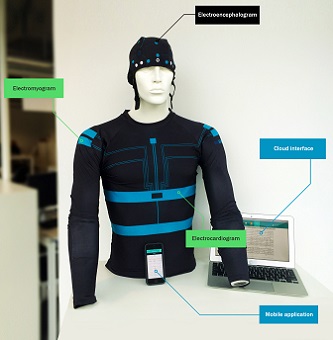Smart Clothing Helps To Diagnose And Monitor Epilepsy
This article is more than 2 years old
 Smart clothing, or wearable technology, has turned heads on the runway, turned movement into music, and may soon make its space debut. It has also entered the medical industry, though often in small steps, such as Google’s contact lenses and this tiny pacemaker. Now, there’s smart clothing that has been designed to diagnose and monitor epilepsy.
Smart clothing, or wearable technology, has turned heads on the runway, turned movement into music, and may soon make its space debut. It has also entered the medical industry, though often in small steps, such as Google’s contact lenses and this tiny pacemaker. Now, there’s smart clothing that has been designed to diagnose and monitor epilepsy.
Bioserenity, a French medical device company, has teamed up with the British Epilepsy Action organization in order to create the WEMU system, which is designed to help improve and speed up the time it takes to make a diagnosis and develop an appropriate treatment regimen for patients.
Usually, epilepsy diagnoses aren’t made until a patient actually has a seizure while being monitored by doctors in a hospital, but there are obvious drawbacks to that. For that to work, a patient has to be at a hospital where those monitoring systems exist, which means that seizures had elsewhere are often not used for diagnosis. This often slows down the time frame for analysis, as well as treatment delivery, which isn’t good for anyone.
 The WEMU system is comprised of a smart shirt and hat (which look surprisingly cool) that both contain battery-powered sensors that monitor the wearer’s brain, heart, and muscles for any indication of seizure activity. When the sensors receive the appropriate data, the garments transmit the readings via Bluetooth to a smartphone app, which then analyzes the data and gives doctors access to it. The data can be securely uploaded to the cloud so your doctors can view it anytime from anywhere. The process allows for any anomaly or possible seizure to be analyzed just after it happens, and for diagnoses to be made remotely, which will facilitate faster and more personalized treatment.
The WEMU system is comprised of a smart shirt and hat (which look surprisingly cool) that both contain battery-powered sensors that monitor the wearer’s brain, heart, and muscles for any indication of seizure activity. When the sensors receive the appropriate data, the garments transmit the readings via Bluetooth to a smartphone app, which then analyzes the data and gives doctors access to it. The data can be securely uploaded to the cloud so your doctors can view it anytime from anywhere. The process allows for any anomaly or possible seizure to be analyzed just after it happens, and for diagnoses to be made remotely, which will facilitate faster and more personalized treatment.
The developers of the system recently launched an Indiegogo campaign to help fund the mass production of WEMU, making it more readily available. It raised over $31,000, though did not meet its goal. Here’s hoping this speed bump doesn’t stop the production and use of such a potentially useful, valuable product.












